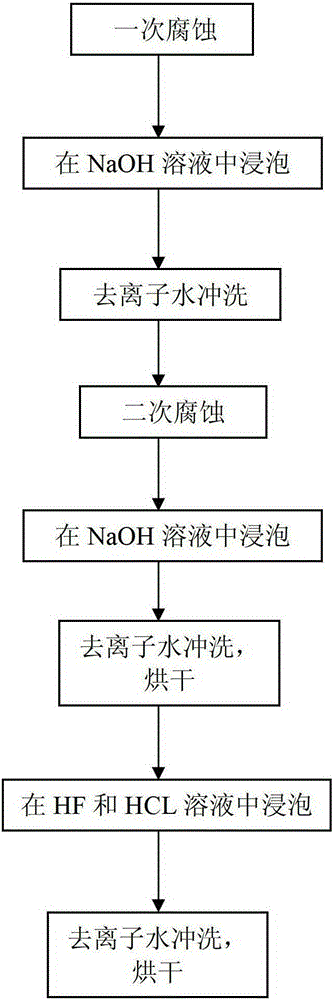A kind of secondary corrosion texturing process on the surface of solar cells
A technology of solar cells and corrosion, which is applied in the direction of sustainable manufacturing/processing, circuits, electrical components, etc., can solve the problems of high silicon wafer thickness requirements, increased costs, complex processes, etc., and achieve uniform and stable texturing and cost savings Effect
- Summary
- Abstract
- Description
- Claims
- Application Information
AI Technical Summary
Problems solved by technology
Method used
Image
Examples
Embodiment 1
[0038] A secondary corrosion texturing process on the surface of a solar cell, comprising the steps of:
[0039] Step 1: Place the wafer in HNO-rich 3 HF and HNO 3 A corrosion is carried out in the mixed solution; among them, HF and HNO 3 The ratio of the mixed solution is HF:HNO 3 =1:5, corrosion temperature: 19°C, corrosion time: 2 minutes;
[0040] Step 2: Soak the once-etched silicon wafer in NaOH solution; the concentration of NaOH solution is 0.5%, and the soaking time is 30 seconds;
[0041] Step 3: Rinse the silicon wafer soaked in step 2 with deionized water;
[0042] Step 4: Place the wafer in HF-rich HF and HNO 3 The secondary corrosion is carried out in the mixed solution; among them, HF and HNO 3 The ratio of the mixed solution is HF:HNO 3 =50:1, corrosion temperature: 19°C, corrosion time: 3 minutes.
[0043] Step 5: Soak the silicon wafer after secondary etching in NaOH solution to remove porous silicon; wherein the concentration of NaOH solution is 0.5%...
Embodiment 2
[0048] A secondary corrosion texturing process on the surface of a solar cell, comprising the steps of:
[0049] Step 1: Place the wafer in HNO-rich 3 HF and HNO 3 A corrosion is carried out in the mixed solution; among them, HF and HNO 3 The ratio of the mixed solution is HF:HNO 3 =1:3, corrosion temperature: 25°C, corrosion time: 1 minute;
[0050] Step 2: Soak the once-etched silicon wafer in NaOH solution; the concentration of NaOH solution is 1%, and the soaking time is 20 seconds;
[0051] Step 3: Rinse the silicon wafer soaked in step 2 with deionized water;
[0052] Step 4: Place the wafer in HF-rich HF and HNO 3 The secondary corrosion is carried out in the mixed solution; among them, HF and HNO 3 The ratio of the mixed solution is HF:HNO 3 =80:1, corrosion temperature: 15°C, corrosion time: 2 minutes.
[0053] Step 5: Soak the silicon wafer after secondary etching in NaOH solution to remove porous silicon; wherein the concentration of NaOH solution is 1%, and...
Embodiment 3
[0058] A secondary corrosion texturing process on the surface of a solar cell, comprising the steps of:
[0059] Step 1: Place the wafer in HNO-rich 3 HF and HNO 3 A corrosion is carried out in the mixed solution; among them, HF and HNO 3 The ratio of the mixed solution is HF:HNO 3 =1:7, corrosion temperature: 15°C, corrosion time: 4 minutes;
[0060] Step 2: Soak the once-etched silicon wafer in NaOH solution; the concentration of NaOH solution is 0.1%, and the soaking time is 50 seconds;
[0061] Step 3: Rinse the silicon wafer soaked in step 2 with deionized water;
[0062] Step 4: Place the wafer in HF-rich HF and HNO 3 The secondary corrosion is carried out in the mixed solution; among them, HF and HNO 3 The ratio of the mixed solution is HF:HNO 3 =30:1, corrosion temperature: 25°C, corrosion time: 5 minutes.
[0063] Step 5: Soak the silicon wafer after secondary etching in NaOH solution to remove porous silicon; wherein the concentration of NaOH solution is 0.1%...
PUM
 Login to View More
Login to View More Abstract
Description
Claims
Application Information
 Login to View More
Login to View More - Generate Ideas
- Intellectual Property
- Life Sciences
- Materials
- Tech Scout
- Unparalleled Data Quality
- Higher Quality Content
- 60% Fewer Hallucinations
Browse by: Latest US Patents, China's latest patents, Technical Efficacy Thesaurus, Application Domain, Technology Topic, Popular Technical Reports.
© 2025 PatSnap. All rights reserved.Legal|Privacy policy|Modern Slavery Act Transparency Statement|Sitemap|About US| Contact US: help@patsnap.com

